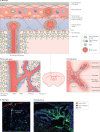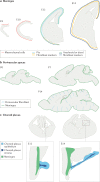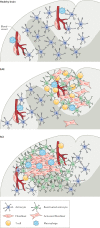Emerging roles for CNS fibroblasts in health, injury and disease
- PMID: 34671105
- PMCID: PMC8527980
- DOI: 10.1038/s41583-021-00525-w
Emerging roles for CNS fibroblasts in health, injury and disease
Abstract
Recent transcriptomic, histological and functional studies have begun to shine light on the fibroblasts present in the meninges, choroid plexus and perivascular spaces of the brain and spinal cord. Although the origins and functions of CNS fibroblasts are still being described, it is clear that they represent a distinct cell population, or populations, that have likely been confused with other cell types on the basis of the expression of overlapping cellular markers. Recent work has revealed that fibroblasts play crucial roles in fibrotic scar formation in the CNS after injury and inflammation, which have also been attributed to other perivascular cell types such as pericytes and vascular smooth muscle cells. In this Review, we describe the current knowledge of the location and identity of CNS perivascular cell types, with a particular focus on CNS fibroblasts, including their origin, subtypes, roles in health and disease, and future areas for study.
© 2021. Springer Nature Limited.
Conflict of interest statement
The authors declare no competing interests.
Figures



Similar articles
-
The fibrotic scar in neurological disorders.Brain Pathol. 2014 Jul;24(4):404-13. doi: 10.1111/bpa.12162. Brain Pathol. 2014. PMID: 24946078 Free PMC article.
-
Central Nervous System Fibroblast-Like Cells in Stroke and Other Neurological Disorders.Stroke. 2021 Jul;52(7):2456-2464. doi: 10.1161/STROKEAHA.120.033431. Epub 2021 May 4. Stroke. 2021. PMID: 33940953 Free PMC article. Review.
-
Fibrotic Scar in CNS Injuries: From the Cellular Origins of Fibroblasts to the Molecular Processes of Fibrotic Scar Formation.Cells. 2022 Aug 2;11(15):2371. doi: 10.3390/cells11152371. Cells. 2022. PMID: 35954214 Free PMC article. Review.
-
Decoding fibrosis in the human central nervous system.Am J Physiol Cell Physiol. 2023 Dec 1;325(6):C1415-C1420. doi: 10.1152/ajpcell.00243.2023. Epub 2023 Oct 9. Am J Physiol Cell Physiol. 2023. PMID: 37811731 Review.
-
Meningeal and choroid plexus cells--novel drug targets for CNS disorders.Brain Res. 2013 Mar 21;1501:32-55. doi: 10.1016/j.brainres.2013.01.013. Epub 2013 Jan 14. Brain Res. 2013. PMID: 23328079 Review.
Cited by
-
Extracellular vesicles derived from the choroid plexus trigger the differentiation of neural stem cells.J Extracell Vesicles. 2022 Nov;11(11):e12276. doi: 10.1002/jev2.12276. J Extracell Vesicles. 2022. PMID: 36325603 Free PMC article.
-
Inhibition of CD44 suppresses the formation of fibrotic scar after spinal cord injury via the JAK2/STAT3 signaling pathway.iScience. 2024 Jan 16;27(2):108935. doi: 10.1016/j.isci.2024.108935. eCollection 2024 Feb 16. iScience. 2024. PMID: 38323002 Free PMC article.
-
Design, Synthesis, and Evaluation of 18F-Labeled Tracers Targeting Fibroblast Activation Protein for Brain Imaging.ACS Pharmacol Transl Sci. 2023 Oct 20;6(11):1745-1757. doi: 10.1021/acsptsci.3c00187. eCollection 2023 Nov 10. ACS Pharmacol Transl Sci. 2023. PMID: 37974629 Free PMC article.
-
Silk-Elastin-like Polymers for Acute Intraparenchymal Treatment of the Traumatically Injured Spinal Cord: A First Systematic Experimental Approach.Pharmaceutics. 2022 Dec 3;14(12):2713. doi: 10.3390/pharmaceutics14122713. Pharmaceutics. 2022. PMID: 36559207 Free PMC article.
-
Stuck on you: Meninges cellular crosstalk in development.Curr Opin Neurobiol. 2023 Apr;79:102676. doi: 10.1016/j.conb.2023.102676. Epub 2023 Feb 9. Curr Opin Neurobiol. 2023. PMID: 36773497 Free PMC article. Review.
References
Publication types
MeSH terms
Grants and funding
LinkOut - more resources
Full Text Sources
Other Literature Sources

